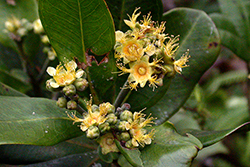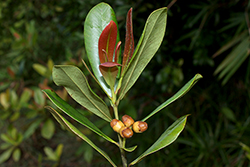e-Flora of Thailand
Volume 7 > Part 4 > Year 2002 > Page 913 > Myrtaceae > Tristaniopsis
2. Tristaniopsis merguensis (Griff.) Peter G.Wilson & J.T.Waterhwfo-0000328623
in Aust. J. Bot. 30: 439. 1982; P.H.Hô, Câyco Viêtnam 2: 65. 1992; Turner, Gard. Bull. Singapore 47: 388. 1995. Tristania merguensis Griff. in J. Asiat. Soc. Bengal 23: 637. 1854; Gagnep. in Lec., Fl. Gén. I.-C. 2: 792. 1920; Ridl., Fl. Malay Penins. 1: 715. 1922; Craib in Fl. Siam. Enum. 1: 626. 1931; Corner, Ways Trees 1: 509. 1940; Kochummen in Ng, Tree Fl. Mal. 3: 252. 1978.
Accepted Name : This is currently accepted.
Description : Tree to 12 m. Outer bark light brown, soon flaking, inner bark light brown. Leaves lanceolate, ovate, obovate, 3–9 by 2–4 cm, acute or obtuse, coriaceous, margins revolute, midrib impressed on upper surface, with a faint intramarginal vein ca 0.5 mm from margin, upper surface drying dark brown, lower surface drying light brown and sometimes gland dotted, both glabrous. Petioles 2 mm, puberulent or absent. Flowers solitary or in clusters, axillary. Bracteoles lanceolate, ca 4 mm, deciduous. Pedicels minute or absent. Calyx infundibuliform, eglandular, 6 mm, puberulent, lobes obtuse ca 1 mm. Pseudostipe ca 1 mm. Petals white, ca 2 mm long, puberulent. Stamens numerous, grouped in 5 antipetalous fascicles, each of 10–15 stamens, filaments pubescent at base, longest filaments ca 2.5 mm, connective with a small apical gland. Style 2 mm. Ovary half-inferior, top pubescent, stigma capitate. Fruits ca 12 mm. Seeds 9 mm by 4 mm, minutely rugose.
Thailand : NORTH-EASTERN: Udon Thani, Nong Khai; EASTERN: Surin; PENINSULAR: Chumphon, Ranong, Surat Thani, Yala.
Distribution : Andaman Islands, Burma (Mergui Archipelago – type), Cambodia, ?Laos, Malay Peninsula, Vietnam.
Ecology : In evergreen forests, often by streams at low altitudes.
Vernacular : Kha nang (ขานาง), khang nang (ขางนาง)(Chumphon).
Uses: The wood is very hard.
Notes: Burmese specimens are all shrubby (to 8 m), whereas Thai specimens are always trees. Burmese material is never glandular whereas Thai material is mostly so. A single specimen H.Koyama & C.Phengklai 49510 from Lampang (Mae Tha) appears intermediate between this species and the next. The leaves and bark are similar to Tristaniopsis merguensis yet the inflorescence is far more densely tomentose than in any other specimens I have seen and has only 6 stamens/fascicle rather like T. burmanica.


